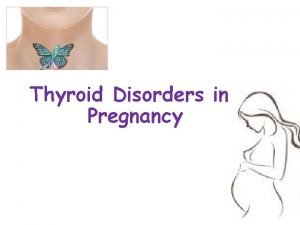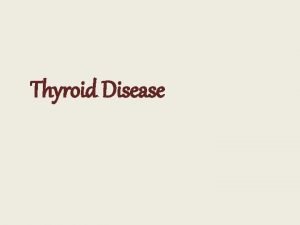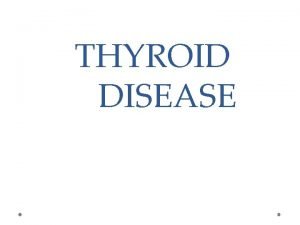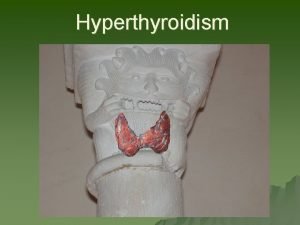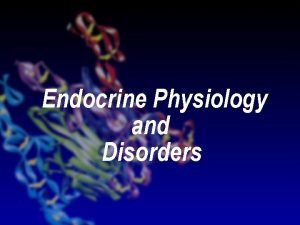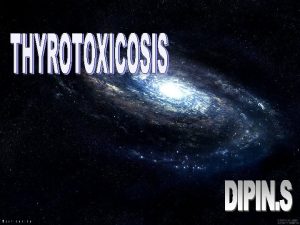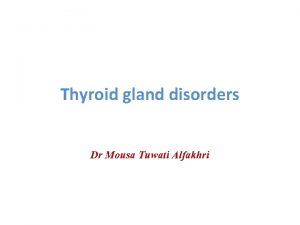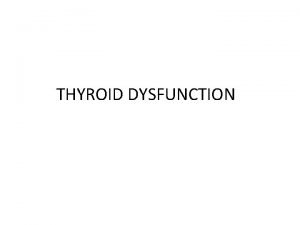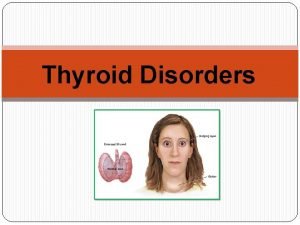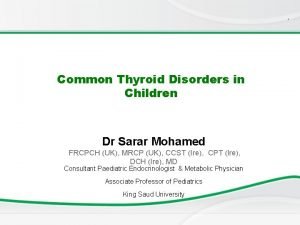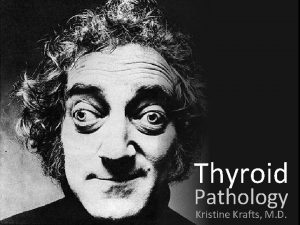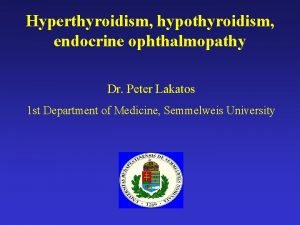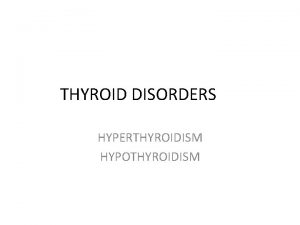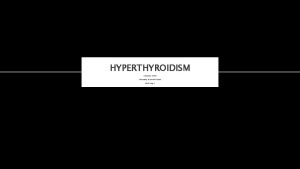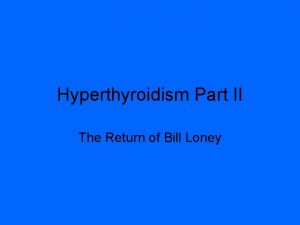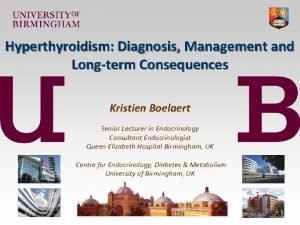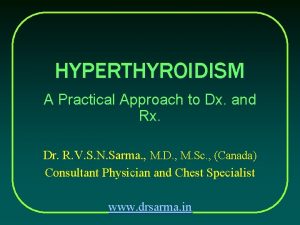Hyperthyroidism Introduction l What is Hyperthyroidism Hyperthyroidism refers












- Slides: 12

Hyperthyroidism

Introduction l What is Hyperthyroidism? – “Hyperthyroidism” refers to overactivity of the thyroid gland leading to excessive synthesis of thyroid hormones and accelerated metabolism in the peripheral tissues. The secretion of thyroid hormone is no longer under the regulatory control of the hypothalamic-pituitary center.

Agenda l We will discuss: – Signs and symptoms – Clinical Statistics – Diagnosis – Treatment – Clinical outcomes of undertreatment and overtreatment – Follow-up care

Clinical Statistics l l l Graves Disease is the most common cause of hyperthyroidism (60 -80%) of all cases. Females are affected more frequently than men 10: 1. 5 Monozygotic twins show 50% concordance rates Incidence peaks from ages 20 -40 Incidence is similar in whites and Asians, but is somewhat decreased for African Americans

Signs and Symptoms – – – – – Tremulousness or jitteriness Exophthalmos Weight loss despite excellent appetite – hypermetabolic state Insomnia Fatigue Palpitations Heat intolerance Sweating Diarrhea Deterioration in handwriting Menstrual irregularities Muscle weakness/wasting manifested as exercise intolerance or difficulty climbing stairs Eye symptoms, which may include pain or diplopia Nervousness Tachycardia Goiter Elevated plasma levels of thyroxin and/or triiodothyronine

Exopthalamos in Graves Disease Lid Lag in Graves Disease

How To Diagnose Hyperthyroidism TSH – expect this to be low l Free T 4 – expect to be high l Nuclear thyroid scintigraphy iodine 123 uptake and scan – expect iodine uptake to increased l Anti-thyroperoxidase antibody levels l TSH-receptor stimulating autoantibody levels (TSI levels) l

Treatments for Hyperthyroidism Medical therapy with antithyroid drugs such as propylthiouracil or methimazole l Ablation of the thyroid gland with radioactive iodine l Subtotal thyroidectomy l Self-limited causes of hyperthyroidism, such as subacute thyroiditis, iodineinduced hyperthyroidism, and exogenous administration of T 4, can be treated symptomatically. For more significant cardiovascular symptoms, beta-adrenergic blockade with propranolol can be helpful. l

Clinical Outcomes of Inadequately treated Hyperthyroidism l Thyrotoxicosis. A life-threatening thyrotoxic crisis (ie, thyroid storm) can l Thyroid storm occurs in patients who have unrecognized or l Initially the acute mortality rate was nearly 100%. In current practice, with aggressive therapy and early recognition of the syndrome, the mortality rate is approximately 20%. l l Severe Weight loss with catabolism of bone and muscle. Cardiac complications and psychocognitive complications l Osteoporosis in men and women. The effect can be particularly occur: fever, tachycardia, neurologic abnormalities, and hypertension, followed by hypotension and shock. It can be Fatal. inadequately treated thyrotoxicosis and a superimposed precipitating event such as thyroid surgery, nonthyroidal surgery, infection, or trauma. devastating in women, in whom the disease may compound the bone loss secondary to chronic anovulation or menopause. Bone loss is accelerated in patients with hyperthyroidism

Clinical Outcomes of Inadequately treated Hyperthyroidism l Sarcopenia and Myopathy l Neonatal hyperthyroidism l Apathetic hyperthyroidism - the only presenting features may be unexplained weight loss or cardiac symptoms such as atrial fibrillation and congestive heart failure. l Cardiac hypertrophy has been reported in thyrotoxicosis of different etiologies. l Severe acropachy can be disabling and can lead to total loss of hand function - clubbing of fingers with osteoarthropathy, including periosteal new bone formation, may occur l Ophthalmopathy - compromised vision and blindness. Visual loss due to corneal lesions or optic nerve compression can be seen.

Follow-up Care l Patients who have been treated for hyperthyroidism need to be followed closely because they may develop HYPOthyroidism or recurrent hyperthyroidism. Follow-up care includes the following: – Reducing medications after 4 -6 weeks; the patient should be totally off anti-thyroid medication in 12 -18 months – Check thyroid function tests every 4 -6 weeks – Monitor closely for remission.

References Hyperthyroidism: www. emedicine. com/med/topic 1109. htm l Hyperthyroidism: www. emedicine. com/ped/topic 1099. htm l Pictures from: www. thachers. org/ images/Graves. jpg l
